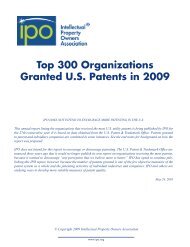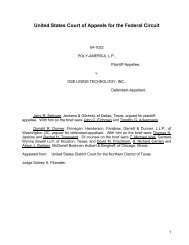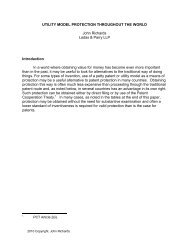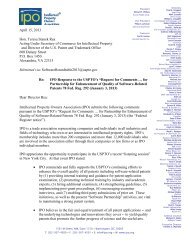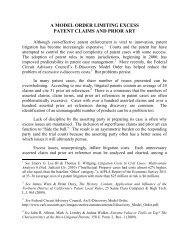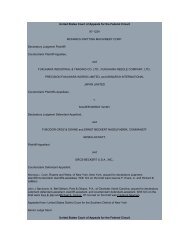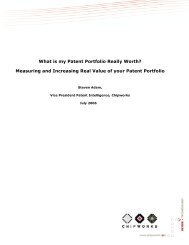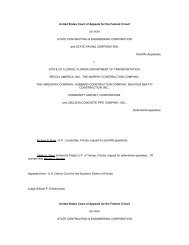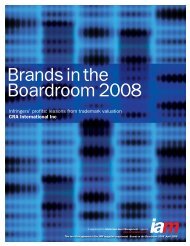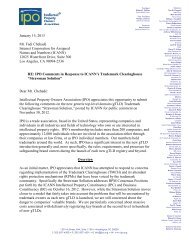IPO Comments to USPTO in Response to Federal Register Notice ...
IPO Comments to USPTO in Response to Federal Register Notice ...
IPO Comments to USPTO in Response to Federal Register Notice ...
Create successful ePaper yourself
Turn your PDF publications into a flip-book with our unique Google optimized e-Paper software.
February 4, 2013<br />
Submitted <strong>to</strong>: rceoutreach@usp<strong>to</strong>.gov<br />
Hon. Terry Stanek Rea<br />
Act<strong>in</strong>g Under Secretary of Commerce for Intellectual Property<br />
and Act<strong>in</strong>g Direc<strong>to</strong>r of the <strong>USPTO</strong><br />
600 Dulany Street<br />
P.O Box 1450<br />
Alexandria, VA 22313<br />
Re:<br />
Dear Direc<strong>to</strong>r Rea:<br />
President<br />
Richard F. Phillips<br />
Exxon Mobil Corp.<br />
Vice President<br />
Philip S. Johnson<br />
Johnson & Johnson<br />
Treasurer<br />
Carl B. Hor<strong>to</strong>n<br />
General Electric Co.<br />
Request for <strong>Comments</strong> on Request for Cont<strong>in</strong>ued Exam<strong>in</strong>ation (RCE)<br />
Practice, 77 Fed. Reg. 72830 (Dec. 6, 2012)<br />
Intellectual Property Owners Association (<strong>IPO</strong>) submits the follow<strong>in</strong>g comments pursuant<br />
<strong>to</strong> the <strong>USPTO</strong>’s “Request for <strong>Comments</strong> on Request for Cont<strong>in</strong>ued Exam<strong>in</strong>ation (RCE)<br />
Practice,” 77 Fed. Reg. 72830 (Dec. 6, 2012) (the “<strong>Federal</strong> <strong>Register</strong> notice”).<br />
<strong>IPO</strong> is a trade association represent<strong>in</strong>g companies and <strong>in</strong>dividuals <strong>in</strong> all <strong>in</strong>dustries and<br />
fields of technology who own, or are <strong>in</strong>terested <strong>in</strong>, <strong>in</strong>tellectual property rights. <strong>IPO</strong>’s<br />
membership <strong>in</strong>cludes more than 200 companies and more than 12,000 <strong>in</strong>dividuals who<br />
are <strong>in</strong>volved <strong>in</strong> the association either through their companies or as <strong>in</strong>ven<strong>to</strong>r, author, law<br />
firm, or at<strong>to</strong>rney members.<br />
<strong>IPO</strong> is concerned with the view (expressed <strong>in</strong> the <strong>Federal</strong> <strong>Register</strong> notice) that the<br />
exam<strong>in</strong>ation of RCE applications “diverts resources away from the exam<strong>in</strong>ation of new<br />
applications.” <strong>IPO</strong> understands the importance of reduc<strong>in</strong>g the backlog of unexam<strong>in</strong>ed<br />
new patent applications, and understands that the <strong>USPTO</strong> must divide its exam<strong>in</strong><strong>in</strong>g<br />
resources among new patent applications, cont<strong>in</strong>u<strong>in</strong>g patent applications (e.g.,<br />
cont<strong>in</strong>uation applications and divisional applications), RCE applications, and reissue<br />
applications. The <strong>Federal</strong> <strong>Register</strong> notice suggests, however, that the exam<strong>in</strong>ation of new<br />
applications is more important than the exam<strong>in</strong>ation of RCE applications. This perspective<br />
loses sight of the fact that the goals of grant<strong>in</strong>g valid patents, stimulat<strong>in</strong>g <strong>in</strong>vestment <strong>in</strong><br />
new technologies, and promot<strong>in</strong>g economic growth will not be met until the exam<strong>in</strong>ation<br />
process—<strong>in</strong>clud<strong>in</strong>g any cont<strong>in</strong>ued exam<strong>in</strong>ation—is completed and a patent is granted.<br />
Thus, <strong>IPO</strong> urges the <strong>USPTO</strong> <strong>to</strong> consider RCEs as part of the entire patent exam<strong>in</strong>ation and<br />
grant<strong>in</strong>g process, and <strong>to</strong> focus its efforts on reduc<strong>in</strong>g application pendency as measured<br />
from fil<strong>in</strong>g <strong>to</strong> grant.<br />
Direc<strong>to</strong>rs<br />
T<strong>in</strong>a M. Chappell<br />
Intel Corp.<br />
Mark Costello<br />
Xerox Corp.<br />
William J. Coughl<strong>in</strong><br />
Ford Global Technologies LLC<br />
Robert DeBerard<strong>in</strong>e<br />
Sanofi-Aventis<br />
Gerald L. DePardo<br />
The Travelers Companies, Inc.<br />
Anthony DiBar<strong>to</strong>lomeo<br />
SAP AG<br />
Bart Eppenauer<br />
Microsoft Corp.<br />
Louis Foreman<br />
Enventys<br />
Scott M. Frank<br />
AT&T<br />
Darryl P. Frickey<br />
Dow Chemical Co.<br />
Bernard J. Graves, Jr.<br />
Eastman Chemical Co.<br />
Krish Gupta<br />
EMC Corporation<br />
Henry Hadad<br />
Bris<strong>to</strong>l-Myers Squibb Co.<br />
Jack E. Haken<br />
Kon<strong>in</strong>klijke Philips Electronics N.V.<br />
Alan W. Hammond<br />
Life Technologies Corp.<br />
Dennis R. Hoerner, Jr.<br />
Monsan<strong>to</strong> Co.<br />
Michael Jaro<br />
Medtronic, Inc.<br />
Lisa Jorgenson<br />
STMicroelectronics, Inc.<br />
Charles M. K<strong>in</strong>zig<br />
GlaxoSmithKl<strong>in</strong>e<br />
David J. Koris<br />
Shell International B.V.<br />
Allen Lo<br />
Google Inc.<br />
Scott McDonald<br />
Mars Incorporated<br />
Jonathan P. Meyer<br />
Mo<strong>to</strong>rola Solutions, Inc.<br />
Steven W. Miller<br />
Procter & Gamble Co.<br />
Douglas K. Norman<br />
Eli Lilly and Co.<br />
Elizabeth A. O’Brien<br />
Covidien<br />
Sean O’Brien<br />
United Technologies, Corp.<br />
Dana Rao<br />
Adobe Systems Inc.<br />
Kev<strong>in</strong> H. Rhodes<br />
3M Innovative Properties Co.<br />
Mark L. Rodgers<br />
Air Products & Chemicals, Inc.<br />
Curtis Rose<br />
Hewlett-Packard Co.<br />
Matthew Sarboraria<br />
Oracle USA, Inc.<br />
Manny Schecter<br />
IBM, Corp.<br />
Steven Shapiro<br />
Pitney Bowes Inc.<br />
Dennis C. Skarvan<br />
Caterpillar Inc.<br />
Russ Slifer<br />
Micron Technology, Inc.<br />
Daniel J. Staudt<br />
Siemens Corp.<br />
Brian K. Stierwalt<br />
ConocoPhillips<br />
Thierry Sueur<br />
Air Liquide<br />
James J. Trussell<br />
BP America, Inc.<br />
Kather<strong>in</strong>e Umpleby<br />
QUALCOMM, Inc.<br />
Roy Waldron<br />
Pfizer, Inc.<br />
Michael Walker<br />
DuPont<br />
BJ Watrous<br />
Apple Inc.<br />
Stuart Watt<br />
Amgen, Inc.<br />
Paul D. Yasger<br />
Abbott Labora<strong>to</strong>ries<br />
Mike Young<br />
Roche Inc.<br />
General Counsel<br />
Michael D. Nolan<br />
Milbank, Tweed, Hadley &<br />
McCloy, LLP<br />
1501 M Street, NW, Suite 1150 ● Wash<strong>in</strong>g<strong>to</strong>n, DC 20005<br />
T: 202-507-4500 ● F: 202-507-4501 ● E: <strong>in</strong>fo@ipo.org ● W: www.ipo.org<br />
Executive Direc<strong>to</strong>r<br />
Herbert C. Wamsley
INTELLECTUAL PROPERTY OWNERS ASSOCIATION<br />
The <strong>Federal</strong> <strong>Register</strong> notice sets forth a number of questions regard<strong>in</strong>g RCE practice. Before<br />
address<strong>in</strong>g many of those questions, we wish <strong>to</strong> provide some suggestions and an overview of<br />
exemplary reasons why <strong>IPO</strong>’s members may file RCEs. First, <strong>IPO</strong> respectfully requests the<br />
<strong>USPTO</strong> <strong>to</strong> consider the follow<strong>in</strong>g suggestions that are not directly encompassed by the <strong>Federal</strong><br />
<strong>Register</strong> notice:<br />
1. Develop and implement “best practices” for the process<strong>in</strong>g of RCEs that<br />
serve the goals of compact prosecution and the prompt grant of allowable<br />
claims.<br />
There currently is significant variability across art units <strong>in</strong> the way that RCEs are<br />
processed and exam<strong>in</strong>ed, as reported <strong>in</strong> this November 19, 2012, Patently-O article:<br />
http://www.patentlyo.com/patent/2012/11/guest-post-the-rce-cliff.html. The <strong>USPTO</strong><br />
should study the practices and polices of different art units and implement best<br />
practices across the exam<strong>in</strong><strong>in</strong>g corps that the serve the goals of compact prosecution<br />
and the prompt grant of allowable claims.<br />
2. Docket RCEs as they were before November 2009, such that Exam<strong>in</strong>ers act<br />
promptly on RCE submissions.<br />
Under the current docket<strong>in</strong>g system, RCEs are the last priority on an Exam<strong>in</strong>er’s<br />
docket, and RCEs can languish for months—or even years—before they are taken up<br />
for exam<strong>in</strong>ation aga<strong>in</strong>. This practice puts the exam<strong>in</strong>ation of an application on hold<br />
<strong>in</strong>def<strong>in</strong>itely, mid-stream <strong>in</strong> prosecution, and is <strong>in</strong>efficient and wasteful of both<br />
applicant and <strong>USPTO</strong> resources. By the time the Exam<strong>in</strong>er takes up an RCE<br />
application, he or she may have forgotten the <strong>in</strong>vention, the prior art, and the details<br />
of the issues raised previously. The Exam<strong>in</strong>er will have <strong>to</strong> take more time <strong>to</strong><br />
refamiliarize him/herself with the application than would have been required if the<br />
RCE were exam<strong>in</strong>ed promptly after fil<strong>in</strong>g.<br />
Post-RCE delays are most frustrat<strong>in</strong>g after an <strong>in</strong>terview. With each month that passes,<br />
the value of hav<strong>in</strong>g had the <strong>in</strong>terview dim<strong>in</strong>ishes, because the Exam<strong>in</strong>er is likely <strong>to</strong><br />
forget the applicant’s explanations and the understand<strong>in</strong>gs that were reached dur<strong>in</strong>g<br />
the <strong>in</strong>terview.<br />
To the extent that the <strong>USPTO</strong> is concerned that applicants use RCEs as an improper<br />
delay tactic, provid<strong>in</strong>g for prompt exam<strong>in</strong>ation of RCEs would discourage such a<br />
practice.<br />
The prompt exam<strong>in</strong>ation of RCEs may become even more important if the <strong>Federal</strong><br />
Circuit upholds the district court’s Patent Term Adjustment (PTA) decision <strong>in</strong><br />
Exelixis v. Kappos, because that decision mandates significant PTA awards when<br />
RCEs are not exam<strong>in</strong>ed promptly. The <strong>USPTO</strong> could m<strong>in</strong>imize the impact of this<br />
decision by promptly exam<strong>in</strong><strong>in</strong>g RCEs.<br />
- 2 -
INTELLECTUAL PROPERTY OWNERS ASSOCIATION<br />
3. Re-align the count system <strong>to</strong> at least not discourage exam<strong>in</strong>ation of RCEs.<br />
In addition <strong>to</strong> the low priority that RCEs are given under the current docket<strong>in</strong>g system,<br />
the current count system dis<strong>in</strong>centivizes the exam<strong>in</strong>ation of RCEs. Indeed, some<br />
Exam<strong>in</strong>ers encourage applicants <strong>to</strong> file cont<strong>in</strong>uation applications <strong>in</strong>stead of RCEs<br />
because they will receive more credit for exam<strong>in</strong><strong>in</strong>g a cont<strong>in</strong>uation application.<br />
However, forc<strong>in</strong>g applicants <strong>to</strong> file cont<strong>in</strong>uation applications is costly, because the<br />
applicant may need <strong>to</strong> re-submit claim amendments and/or evidence <strong>in</strong> the<br />
cont<strong>in</strong>uation application <strong>to</strong> br<strong>in</strong>g it up <strong>to</strong> date with the pend<strong>in</strong>g application.<br />
4. Do not use the fee structure <strong>to</strong> penalize RCEs.<br />
As set forth below, applicants have a number of legitimate reasons for fil<strong>in</strong>g RCEs.<br />
Thus, <strong>IPO</strong> does not believe that the <strong>USPTO</strong> should use the fee structure <strong>to</strong> discourage<br />
or penalize the fil<strong>in</strong>g of RCEs. As <strong>IPO</strong> noted <strong>in</strong> its <strong>Comments</strong> <strong>to</strong> “<strong>Notice</strong> of Proposed<br />
Rulemak<strong>in</strong>g: Sett<strong>in</strong>g and Adjust<strong>in</strong>g Patent Fees,” 77 Fed. Reg. 55028 (September 6,<br />
2012), <strong>IPO</strong> does not believe that rais<strong>in</strong>g fil<strong>in</strong>g fees is the solution <strong>to</strong> the RCE problem.<br />
The <strong>USPTO</strong>’s f<strong>in</strong>al fee schedule (effective March 19, 2013) <strong>in</strong>creases the large entity<br />
RCE fee from $930 <strong>to</strong> $1,200 for the first RCE and <strong>to</strong> $1,700 for the second and each<br />
subsequent RCE. These fees are unduly high and fail <strong>to</strong> take <strong>in</strong><strong>to</strong> account prosecution<br />
realities that make RCEs necessary, as outl<strong>in</strong>ed below. Moreover, <strong>IPO</strong> does not believe<br />
that applicants should have <strong>to</strong> pay such high RCE fees when RCEs are not exam<strong>in</strong>ed<br />
promptly, but <strong>in</strong>stead are relegated <strong>to</strong> the back of the exam<strong>in</strong>ation queue.<br />
In addition <strong>to</strong> the suggestions above, <strong>IPO</strong> believes the follow<strong>in</strong>g overview of exemplary reasons 1 why our<br />
members may file RCEs will help the Office <strong>to</strong> better understand <strong>IPO</strong>’s positions.<br />
<br />
<br />
To obta<strong>in</strong> entry and consideration of an IDS after a f<strong>in</strong>al Office Action.<br />
o Foreign agents do not always forward references cited <strong>in</strong> foreign counterpart<br />
applications <strong>in</strong> time for mak<strong>in</strong>g a 1.97(e)(1) statement.<br />
o A foreign patent office may cite potentially relevant prior art <strong>in</strong> an application<br />
that is not a “counterpart” application, such that a 1.97(e)(1) statement would<br />
not be appropriate.<br />
o Many Applicants are hesitant <strong>to</strong> use 1.97(e)(2) statements when it may be<br />
difficult <strong>to</strong> confirm that the <strong>in</strong>formation be<strong>in</strong>g submitted was not known <strong>to</strong><br />
any person encompassed by Rule 56 more than three months ago.<br />
To amend claims or present new evidence <strong>to</strong> address a new rejection <strong>in</strong> a f<strong>in</strong>al Office<br />
Action.<br />
o The new rejection may have been made <strong>in</strong> response <strong>to</strong> previous claim<br />
amendments or may cite prior art submitted <strong>in</strong> an IDS after the first Office<br />
Action.<br />
1 See Gary Ganzi, “Patent Cont<strong>in</strong>uation Practice and Public <strong>Notice</strong>: Can They Coexist?” 89 J. Pat. & Trademark<br />
Off. Soc’y 545 (2007).<br />
- 3 -
INTELLECTUAL PROPERTY OWNERS ASSOCIATION<br />
<br />
<br />
<br />
<br />
To amend claims or present new evidence <strong>to</strong> address a rejection, where previous<br />
arguments, amendments, and/or evidence was not successful.<br />
o It often takes more than one “round” of prosecution for the applicant <strong>to</strong> fully<br />
understand the Exam<strong>in</strong>er’s position and for the Exam<strong>in</strong>er <strong>to</strong> fully understand<br />
the <strong>in</strong>vention.<br />
o When the first Office Action conta<strong>in</strong>s numerous 112, 2 rejections, 112, 1<br />
rejections, and prior art rejections, it may take more than one “round” of claim<br />
amendments and explanations <strong>to</strong> reach agreement on suitable claim language.<br />
o Even if the Applicant is confident of the patentability of the claims, an RCE<br />
may be viewed as a more favorable option than appeal because of the backlog<br />
at the Board.<br />
To amend claims or present new evidence <strong>to</strong> place the application <strong>in</strong> better condition<br />
for appeal.<br />
In response <strong>to</strong> a request by the Exam<strong>in</strong>er with a suggestion that the RCE will result <strong>in</strong><br />
allowance (and the Exam<strong>in</strong>er will earn counts for both the RCE and the allowance).<br />
To delay prosecution or postpone allowance. Because an RCE must be accompanied<br />
by a bona fide response <strong>to</strong> the f<strong>in</strong>al office action, fil<strong>in</strong>g an RCE is only useful as a<br />
“delay” tactic because of the way that RCEs are docketed and exam<strong>in</strong>ed. When RCEs<br />
were exam<strong>in</strong>ed as “amended” cases, fil<strong>in</strong>g an RCE did not significantly delay<br />
prosecution.<br />
With respect <strong>to</strong> the specific questions posed <strong>in</strong> the <strong>Federal</strong> <strong>Register</strong> notice, <strong>IPO</strong> provides the<br />
follow<strong>in</strong>g general responses <strong>to</strong> selected questions. These responses are not <strong>in</strong>tended <strong>to</strong> be<br />
representative of the experiences or op<strong>in</strong>ions of specific <strong>IPO</strong> member companies or <strong>in</strong>dividuals.<br />
(2) What change(s), if any, <strong>in</strong> Office procedure(s) or regulation(s) would reduce your<br />
need <strong>to</strong> file RCEs?<br />
<br />
<br />
<br />
<br />
<strong>IPO</strong> commends the <strong>USPTO</strong> on its creativity and efforts <strong>in</strong> formulat<strong>in</strong>g and<br />
implement<strong>in</strong>g the After-F<strong>in</strong>al Consideration Pilot program. <strong>IPO</strong> would like <strong>to</strong> see<br />
this program made permanent. Because <strong>IPO</strong> members have experienced mixed<br />
application of this program, <strong>IPO</strong> asks that the <strong>USPTO</strong> ensure widespread tra<strong>in</strong><strong>in</strong>g on<br />
the program and <strong>in</strong>centives <strong>to</strong> encourage after-f<strong>in</strong>al consideration.<br />
More will<strong>in</strong>gness of Exam<strong>in</strong>ers <strong>to</strong> suggest claim amendments and/or identify<br />
allowable subject matter.<br />
More complete search<strong>in</strong>g of all claimed embodiments <strong>to</strong> avoid piecemeal prosecution<br />
and serial prior art rejections.<br />
More flexibility <strong>in</strong> the consideration and entry of claim amendments and evidence<br />
after a f<strong>in</strong>al office action, such as mak<strong>in</strong>g permanent the After-F<strong>in</strong>al Consideration<br />
- 4 -
INTELLECTUAL PROPERTY OWNERS ASSOCIATION<br />
Pilot program and provid<strong>in</strong>g more widespread tra<strong>in</strong><strong>in</strong>g and <strong>in</strong>centives <strong>to</strong> encourage<br />
after-f<strong>in</strong>al consideration.<br />
(<strong>IPO</strong> members have experienced mixed implementation of this program, with some<br />
Exam<strong>in</strong>ers be<strong>in</strong>g very will<strong>in</strong>g <strong>to</strong> work with applicants after f<strong>in</strong>al, and others refus<strong>in</strong>g<br />
<strong>to</strong> consider even m<strong>in</strong>or, clerical claim amendments.)<br />
<br />
<br />
More flexibility <strong>in</strong> the consideration and entry of claim amendments and evidence<br />
after a f<strong>in</strong>al office action, particularly after an <strong>in</strong>terview.<br />
More guidance on when claim amendments/evidence can be entered after f<strong>in</strong>al.<br />
o To address a new ground of rejection <strong>in</strong> a f<strong>in</strong>al office action?<br />
o To address a new reference cited <strong>in</strong> a f<strong>in</strong>al office action?<br />
o To address a new argument set forth <strong>in</strong> a f<strong>in</strong>al office action (e.g., a new<br />
explanation of the claim <strong>in</strong>terpretation be<strong>in</strong>g applied, a citation of a different<br />
portion of a reference, or a new explanation of why a reference is be<strong>in</strong>g<br />
cited)?<br />
o If experimental data addresses an issue first raised <strong>in</strong> the f<strong>in</strong>al office action?<br />
o If experimental data was not available before (such as results of a long-term<br />
study)?<br />
The <strong>Federal</strong> <strong>Register</strong> notice questioned why more Applicants do not submit afterf<strong>in</strong>al<br />
responses, but <strong>in</strong>stead proceed directly with RCEs. Many <strong>IPO</strong> members report<br />
experience with Exam<strong>in</strong>ers who will not enter any amendments after f<strong>in</strong>al, and so<br />
their practice is <strong>to</strong> file an RCE <strong>to</strong> m<strong>in</strong>imize extension of time/notice of appeal fees<br />
and expedite prosecution.<br />
<br />
<br />
<br />
<br />
General ability <strong>to</strong> present claim amendments and/or evidence <strong>to</strong> address new<br />
rejections raised <strong>in</strong> a f<strong>in</strong>al office action.<br />
More <strong>in</strong>formation provided <strong>in</strong> an advisory action relat<strong>in</strong>g <strong>to</strong> the Exam<strong>in</strong>er’s reaction<br />
<strong>to</strong> after-f<strong>in</strong>al claim amendments, <strong>to</strong> decide whether further progress might be made <strong>in</strong><br />
an RCE or whether the issues are ripe for appeal.<br />
Elim<strong>in</strong>ation of MPEP § 706.07(b), which permits an Exam<strong>in</strong>er <strong>to</strong> make the first office<br />
action after an RCE another f<strong>in</strong>al office action under many circumstances, thus<br />
necessitat<strong>in</strong>g yet another RCE.<br />
Discourag<strong>in</strong>g Exam<strong>in</strong>ers from provid<strong>in</strong>g notice <strong>in</strong> a notice of allowance or ex parte<br />
Quayle action that <strong>in</strong>formation submitted <strong>in</strong> an IDS was not considered (e.g., due <strong>to</strong><br />
an <strong>in</strong>complete citation or miss<strong>in</strong>g copy). Once prosecution on the merits is closed, an<br />
RCE may be required <strong>to</strong> re-submit the <strong>in</strong>formation <strong>in</strong> a new IDS.<br />
- 5 -
INTELLECTUAL PROPERTY OWNERS ASSOCIATION<br />
(3) What effect(s), if any, does the Office’s <strong>in</strong>terview practice have on your decision <strong>to</strong><br />
file an RCE? and (4) If, on average, <strong>in</strong>terviews with exam<strong>in</strong>ers lead you <strong>to</strong> file fewer<br />
RCEs, at what po<strong>in</strong>t dur<strong>in</strong>g prosecution do <strong>in</strong>terviews most regularly produce this<br />
effect?<br />
Overall, most <strong>IPO</strong> members f<strong>in</strong>d <strong>in</strong>terviews <strong>to</strong> be very helpful <strong>in</strong> advanc<strong>in</strong>g prosecution.<br />
Thus, on the whole, the ability <strong>to</strong> conduct <strong>in</strong>terviews reduces the need <strong>to</strong> file RCEs.<br />
Speak<strong>in</strong>g very generally, <strong>in</strong>terviews held before a f<strong>in</strong>al office action may reduce the need<br />
<strong>to</strong> file an RCE, if agreement can be reached and any necessary amendments and/or<br />
evidence can be submitted before a f<strong>in</strong>al office action. However, the issues do not always<br />
appear <strong>to</strong> be ripe for an <strong>in</strong>terview after the first office action. Moreover, many <strong>IPO</strong><br />
members prefer <strong>to</strong> try <strong>to</strong> address the first rejections <strong>in</strong> a written response before <strong>in</strong>curr<strong>in</strong>g<br />
the expenses associated with an <strong>in</strong>terview.<br />
Interviews held after a f<strong>in</strong>al office action also may reduce the need <strong>to</strong> file an RCE, if<br />
agreement can be reached and any necessary amendments and/or evidence are entered<br />
after-f<strong>in</strong>al because they are likely <strong>to</strong> place the application <strong>in</strong> condition for allowance.<br />
(5) What actions could be taken by either the Office or applicants <strong>to</strong> reduce the need <strong>to</strong><br />
file evidence (not <strong>in</strong>clud<strong>in</strong>g an IDS) after a f<strong>in</strong>al rejection?<br />
Many <strong>IPO</strong> members are reluctant <strong>to</strong> submit evidence unless it appears <strong>to</strong> be absolutely<br />
necessary because of the scrut<strong>in</strong>y that it can draw dur<strong>in</strong>g litigation. Thus, many <strong>IPO</strong><br />
members view the submission of evidence as a “last resort,” and so are not likely <strong>to</strong><br />
submit evidence <strong>in</strong> response <strong>to</strong> a first office action. As a result, it may be difficult <strong>to</strong><br />
reduce the need <strong>to</strong> file evidence after a f<strong>in</strong>al office action.<br />
(6) When consider<strong>in</strong>g how <strong>to</strong> respond <strong>to</strong> a f<strong>in</strong>al rejection, what fac<strong>to</strong>r(s) cause you <strong>to</strong><br />
favor the fil<strong>in</strong>g of an RCE?<br />
Speak<strong>in</strong>g generally, <strong>IPO</strong> members consider fil<strong>in</strong>g an RCE if they want <strong>to</strong> present claim<br />
amendments and/or evidence <strong>in</strong> response <strong>to</strong> a f<strong>in</strong>al office action. When decid<strong>in</strong>g whether<br />
<strong>to</strong> file an RCE, <strong>IPO</strong> members may consider whether the claim amendments and/or<br />
evidence are likely <strong>to</strong> be entered after f<strong>in</strong>al and, if not, may file an RCE <strong>in</strong> the first<br />
<strong>in</strong>stance, <strong>to</strong> avoid the expense and delay associated with fil<strong>in</strong>g an after-f<strong>in</strong>al response,<br />
receiv<strong>in</strong>g an advisory action, and then fil<strong>in</strong>g an RCE (likely requir<strong>in</strong>g extension of time<br />
and/or notice of appeal fees). This assessment may be based on the scope of the claim<br />
amendments, the nature of the evidence, experience with the particular Exam<strong>in</strong>er, or an<br />
<strong>in</strong>dication from the Exam<strong>in</strong>er that the claim amendments and/or evidence will or will not<br />
be entered after f<strong>in</strong>al.<br />
<strong>IPO</strong> members also consider fil<strong>in</strong>g an RCE if they believe that they can make any progress<br />
with the Exam<strong>in</strong>er, or if they want <strong>to</strong> place the application <strong>in</strong> better condition for appeal,<br />
such as by amend<strong>in</strong>g the claims or submitted evidence that supports patentability.<br />
- 6 -
INTELLECTUAL PROPERTY OWNERS ASSOCIATION<br />
(7) When consider<strong>in</strong>g how <strong>to</strong> respond <strong>to</strong> a f<strong>in</strong>al rejection, what fac<strong>to</strong>r(s) cause you <strong>to</strong><br />
favor the fil<strong>in</strong>g of an amendment after f<strong>in</strong>al (37 CFR 1.116)?<br />
<strong>IPO</strong> members who are concerned that the Exam<strong>in</strong>er may <strong>in</strong>voke MPEP § 706.07(b) may<br />
file an after-f<strong>in</strong>al response <strong>in</strong>stead of an RCE, <strong>to</strong> m<strong>in</strong>imize the chances that the first office<br />
action after the RCE will be a “f<strong>in</strong>al” office action.<br />
<strong>IPO</strong> members who believe that the claim amendments and/or evidence should or will be<br />
entered and considered after f<strong>in</strong>al are likely <strong>to</strong> file an after-f<strong>in</strong>al response <strong>in</strong>stead of an<br />
RCE <strong>in</strong> the first <strong>in</strong>stance.<br />
<strong>IPO</strong> members who are mak<strong>in</strong>g amendments and/or submitt<strong>in</strong>g evidence <strong>to</strong> place the<br />
application <strong>in</strong> better condition for appeal may file an after-f<strong>in</strong>al response <strong>in</strong>stead of an<br />
RCE <strong>in</strong> the first <strong>in</strong>stance.<br />
(8) Was your after f<strong>in</strong>al practice impacted by the Office’s change <strong>to</strong> the order of<br />
exam<strong>in</strong>ation of RCEs <strong>in</strong> November 2009? If so, how?<br />
Before the changes <strong>to</strong> the exam<strong>in</strong>ation of RCEs, fil<strong>in</strong>g an RCE generally was considered<br />
<strong>to</strong> add <strong>to</strong> the expense of patent prosecution, but not the time. Now that RCEs can be<br />
associated with significant delays mid-stream <strong>in</strong> the exam<strong>in</strong>ation process, many <strong>IPO</strong><br />
members file RCEs as a “last resort.” Indeed, some Exam<strong>in</strong>ers have suggested <strong>to</strong> <strong>IPO</strong><br />
members that they file cont<strong>in</strong>uation applications <strong>in</strong>stead of RCEs, because cont<strong>in</strong>uation<br />
applications usually are taken up for exam<strong>in</strong>ation sooner.<br />
(This option is not always the best for the applicant because fil<strong>in</strong>g a cont<strong>in</strong>uation<br />
application can be more costly if amendments and/or evidence need <strong>to</strong> be resubmitt<strong>in</strong>g <strong>in</strong><br />
the cont<strong>in</strong>uation application and because any patent term adjustment accrued <strong>in</strong> the<br />
pend<strong>in</strong>g application will not carry over <strong>to</strong> the cont<strong>in</strong>uation application.)<br />
A number of <strong>IPO</strong> members also report fil<strong>in</strong>g appeals <strong>in</strong>stead of RCEs, particularly now<br />
that the exam<strong>in</strong>ation of RCEs can be substantially delayed and take as long as an appeal.<br />
This strategy also can have advantages under the Patent Term Adjustment (PTA) rules,<br />
because a favorable resolution on appeal can lead <strong>to</strong> a PTA award, whereas an RCE<br />
usually has a negative impact on PTA.<br />
(10) What strategy/strategies do you employ <strong>to</strong> avoid RCEs?<br />
<strong>IPO</strong> members may pursue the follow<strong>in</strong>g strategies <strong>in</strong> appropriate cases:<br />
Present<strong>in</strong>g foreseeable fall-back positions <strong>in</strong> orig<strong>in</strong>al dependent claims;<br />
Present<strong>in</strong>g additional fall-back positions <strong>in</strong> dependent claims submitted <strong>in</strong> response<br />
<strong>to</strong> the first office action;<br />
- 7 -
INTELLECTUAL PROPERTY OWNERS ASSOCIATION<br />
Interview<strong>in</strong>g early <strong>in</strong> the prosecution process (i.e., before a f<strong>in</strong>al office action)<br />
Submitt<strong>in</strong>g evidence <strong>in</strong> response <strong>to</strong> the first office action.<br />
* * * * *<br />
<strong>IPO</strong> thanks the <strong>USPTO</strong> for consider<strong>in</strong>g these comments and would welcome any further dialogue<br />
or opportunity <strong>to</strong> provide additional <strong>in</strong>formation <strong>to</strong> assist <strong>in</strong> the Office’s efforts <strong>to</strong> reduce the<br />
need for RCEs.<br />
S<strong>in</strong>cerely,<br />
Richard F. Phillips<br />
President<br />
- 8 -



